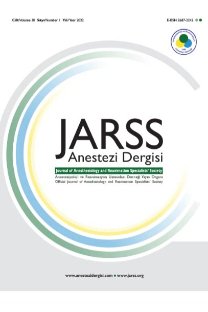Laparoskopik kolesistektomilerde TİVA ve VİMA'nın hemodinami ve derlenme özellikleri
Anesteziden uyanma dönemi, Anestezi, ven içi, Propofol, Kolesistektomi, laparoskopik
Hemodynamic and recovery characteristics of tiva and vima in laparoscopic cholecystectomy
Anesthesia Recovery Period, Anesthesia, Intravenous, Propofol, Cholecystectomy, Laparoscopic,
___
- 1. Taşçı H, Çiçek Y. Laparoskopik Kolesistektami- İlk yüz vakalık serinin incelenmesi. Çağdaş Cerrahi Dergisi 1993; 7: 68-72.
- 2. Smith 1. Sevoflurane : a long-awaited volatile anaesthetic. BJA 1996:76:435-45
- 3. Egan TD.Remifentanil.Pharmacokinelics and Pharmacodynamics. Clin. Pharmacokinet 1995; 29 (2): 80-94.
- 4. Gopinaih R, Murray JM, Fee J P H. Recovery afler induction and maintenance of anaesthesia with sevoflurane/oxygen in adult patients. A comparison with propofol / sevoflurane / oxygen. BJA 1997:78:461.
- 5. Fredman B, Nathanson MH. Sevoflurane for outpatient anesthesia: a comparison with propofol. Anesih Analg 1995; 81 (4): 823-28.
- 6. Jahnson GP, Thomas H. Mask induction and one-lung ventilation with sevoflurane. Anaeslhesist 1998; 47: 52-7.
- 7. Smith I, Thwaites AJ. Targe-controlled propofol vs sevoflurane: a double-blind, randomised comparison in day-case anaesthesia. Anaesthesia 1999; 54(8): 745-52.
- 8. Thwaites A. Inhalation induction with sevoflurane: a double-blind comparison with propofol. B JA 1997; 78: 356-61.
- 9. Watson KR, Shah MV. Clinical comparison of 'single-agent' anaesthesia with sevoflurane versus target-controlled infusion of propofol. BJA 2000; 85(4): 541-6.
- 10. Nelskyla K, Korttila K. Comparison of sevoflurane-nitrous oxide and propofol-alfentanil-nitrous oxide anaesthesia for minor gynaecological surgery. BJA 1999; 83{4): 576-9.
- 11. Philip BK, Lombard LL. Comparison of vital capucitiy induction with sevoflurane to intravenous induction with propofol for adult ambulatory anesthesia. Anesth Anaig 1999; 89: 623-7.
- 12. Hogue CW, Bowdle TA. A multicenter evaluation of total intravenous anesthesia with remifentanil and propofol for elective inpatient surgery. Anesth Analg 1996; 83: 279-85.
- 13. Peduto VA, Mezzetti D. Sevoflurane provides betler recovery than propofol plus fentanly in anaesthesia for day-case surgery. Eur J Anaesthesiol 2000; 17(2): 138-43.
- 14. Juckcnhofel S, Feisel C, TIVA with propofol-rcmifenlanil or balanced anaesthesia with sevoflurane - fentanil in laparoscopic operations. Hemodynamics, awakening and adverse effects. Anaesthesist 1999; 48(11): 807-12.
- ISSN: 1300-0578
- Yayın Aralığı: 4
- Başlangıç: 1993
- Yayıncı: Betül Kartal
Sedoanaljezide farklı dozda remifentanil uygulaması
Hakkı ÜNLÜGENÇ, Mehmet ÖZALEVLİ, Tayfun GÜLER, Geylan IŞIK
Koroner revaskülarizasyon operasyonlarında sevofluran'ın böbrek fonksiyonlarına etkisi
Fahriye GÜLER, Tuncer KOÇAK, Füsun GÜZELMERİÇ, Halide OĞUŞ, Mustafa GÜLER, Meral SEVİNÇ, Çiğdem YAKUT
Öztin Cemile ÖĞÜN, ATEŞ DUMAN, Çetin ÇELİK, Esma Nur KIRGIZ, Selmin ÖKESLİ
Meyancı Güniz KÖKSAL, Elif AŞKIN, HÜSEYİN ÖZ
Laparoskopik kolesistektomilerde TİVA ve VİMA'nın hemodinami ve derlenme özellikleri
Okutan Ebru ALAGÖZ, BELGİN AKAN, Murat TEKİN, Demet ALBAYRAK, Nermin GÖĞÜŞ
Günübirlik anestezi sonrası kognitif yetmezlik sorgulaması
Seda Banu AKINCI, Halide CEYHAN, Zeynep COŞKUN, MELİH AKINCI, Saadet ÖZGEN
H. Ömer AYANOĞLU, Sezgin ULUKAYA, NÜZHET SEDEN KOCABAŞ, A. Zeki ÇÖKMEZ
Kanser ağrısı ve transdermal fentanil kullanımı
Emine ÖZYUVACI, Aysel ALTAN, Şule VATANSEVER, Abdulkadir İSKENDER
Morbid obez hastalarda cisatrakuryumun nöromusküler iletime etkileri
ZİYA SALİHOĞLU, Şener DEMİROLUK, Yıldız KÖSE
Anestezi indüksiyonu sırasında iki farklı dozda remifentanil infüzyonunun karşılaştırılması
Tezcan Gönül KELEŞ, E. Alp YENTÜR, Melek SAKARYA, Verda TOPRAK, Gülay OK, Taner TAŞYÜZ
